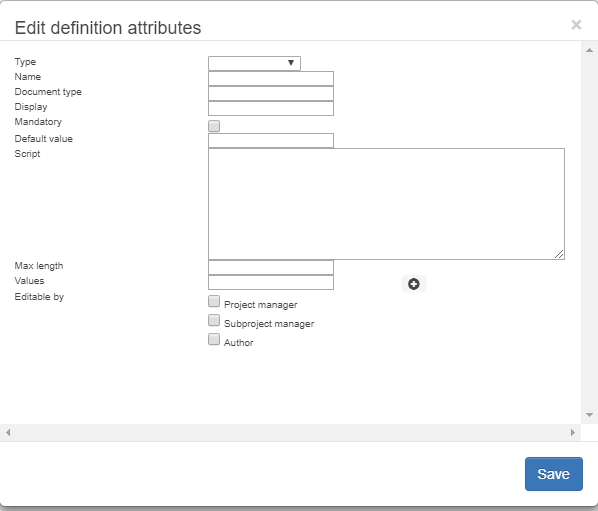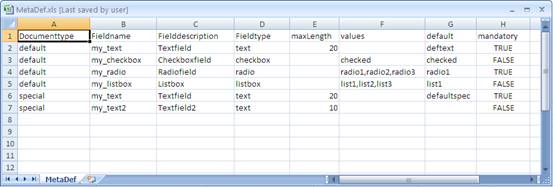A
definition of the dynamic metadata applicable here can be individually added to
each project. The default metadata can be extended by this. These dynamic
fields are then visible when editing and displaying the metadata. The
specification of a definition is optional.
The
metadata can be defined on the admin page of edoc. Open the “Projects” tab, and
then select “Metadata definition”

Fig. 6: Metadata
defintion tab
There
are two possibilities to add metadata, either individual fields can be created
clicking on the ![]() icon, or
metadata can be imported with the
icon, or
metadata can be imported with the ![]() icon
icon

Fig. 7: Metadata fields
If you
click on the icon to create a single metadata field, the following window will
be opened:

Fig. 8: Edit definition
attributes
Type
Type
of field
Name
The
name used for the attribute by edoc
Document
type
Used
to group metadata fields
Display
The
Name shown in eDoc
Mandatory
Determine
whether a field is needed to be set
Default
Value
A
value that will be set by default and can be changed
Script
A Script
that will be run on this field
Max
length
The
max possible length of the field
Values
Used
by the field types „Listbox“, „ListboxServer“ or „ListboxChained“
Editiable
by
Select
which users can edit the values
Alternatively,
a definition of the dynamic metadata applicable here can be individually added
to each project. The default metadata can be extended by this. These dynamic
fields are then visible when editing and displaying the metadata. The
specification of a definition is optional.
This
is done by uploading a file through the administration page by clicking on the ![]() button.
button.
The
definition of the dynamic metadata is made in a tab separated TSV file. This
can also be created and modified with Excel with the file extension .xls.

Fig.
9: Excel file extension
1.
The text
marked in yellow is intended as a template for the definition of metadata.
2.
Copy the
text and paste into an Excel file.
3.
Save the
file as text (tab separated) (*.txt).
Documenttype Fieldname Fielddescription Fieldtype maxLength values default mandatory script
Default my_text Textfield text 20 default text TRUE
Default my_checkbox Checkboxfield checkbox checked checked FALSE
Default my_text Radiobutton radio radio1,
radio2, radio3 radio1 TRUE
Default my_text Listbox listbox list1,
list2, list3 list1 FALSE
special my_text Textfield text 20 Sample co. TRUE
special my_text Textfield2 text 10 FALSE
The
first line contains the column headers. The remaining lines each define a field
of a specified document type. The document type can be used to individually
determine for each document the dynamic fields with which the respective
document should be equipped.
The
first defined document type is the default document type and is directly
displayed when creating a new document.
The
following column details are required for a field definition:
Documenttype
This
field is used to group metadata fields.
If
several document types are defined as in the example, a selection is generated
with the associated field descriptions
Fieldname
Name
of the field. The my_ prefix can be used to express that this field is a
self-defined dynamic field.
Fielddescription
Field
title to be displayed. If this is required in multiple languages, it can then
be made in the language constant definition specified for the user interface.
The definition is formed as follows: nls.edit.meta.dyn. + fieldname = field
title
Example:
nls.edit.meta.dyn.my_text=My text field
Fieldtype
Type
of field in the creation. The following specifications are possible: text,
listbox, radio, checkbox
"text"
Text input field
"listbox"
Selection of an entry from a preset list
"listboxserver"
Selection of an entry from a preset list where the list of values is not
managed in this file, but are stored on the server in the database. The values
can be managed via the eDoc administration pages.
"listboxchained"
Selection of an entry from a preset list which leads to a selection from
another nested list. The list of values is not managed in this file, but is
stored on the server in the database. The values can be managed via the eDoc
administration pages.

Fig. 10: Structure
This
is the structure of the text file:
Documenttype
Fieldname Fielddescription Fieldtype maxLength values default mandatory script
Default
listboxchained_dash_level_0 Hovedkategori (nivå 1) listboxchained AIC
FALSE
Default
listboxchained_dash_level_1 Anleggstype (nivå 2) listboxchained AIC listboxchained_dash_level_0 FALSE
Default
listboxchained_dash_level_2 Prosess segment (nivå 3) listboxchained AIC listboxchained_dash_level_1 FALSE
Default
listboxchained_dash_level_3 Hovedsystem (nivå 4) listboxchained AIC listboxchained_dash_level_2 FALSE
Default
listboxchained_dash_level_4 Undersystem (nivå 5) listboxchained AIC listboxchained_dash_level_3 FALSE
"autocomplete"
Selection of an entry from a preset list where the list is adapted dynamically
in accordance with the characters entered. The values of the list are stored in
the database and are managed via the eDoc administration pages. This field type
is ideal for very long lists. For the autocomplete field type, the script field
must be defined.
"autonumber" Automatic issue of consecutive numbers. The
consecutive number can be combined with other attributes and also integrated in
the document name.
"radio"
Selection of an element from predefined elements
"checkbox"
Selection of an entry
maxLength
Specification
of a maximum length for text fields.
values
Definition
of selections. This specification is relevant for listbox, checkbox and radio
field types. For "checkbox", a value can be specified which is taken
when selecting the checkbox. For "listbox" and "radio", a
list of possible values can be specified with commas.
default
A
value can be preset here which is already entered as a default value for the
creation.
mandatory
Definition
of whether the field is mandatory (true) or not (false).
Editable by
One the selected roles are given the privileges to modify the attribute. To all
other roles the attributes is read-only.